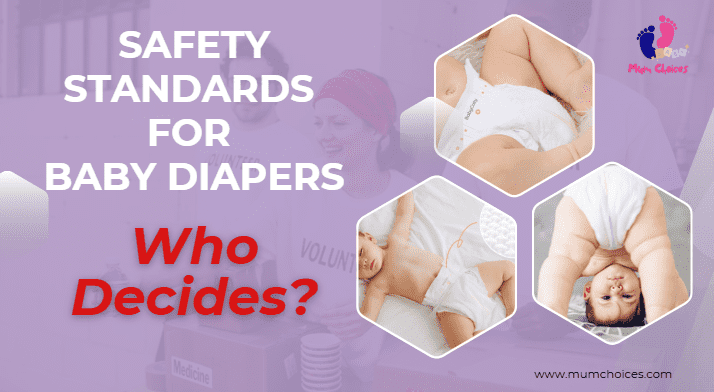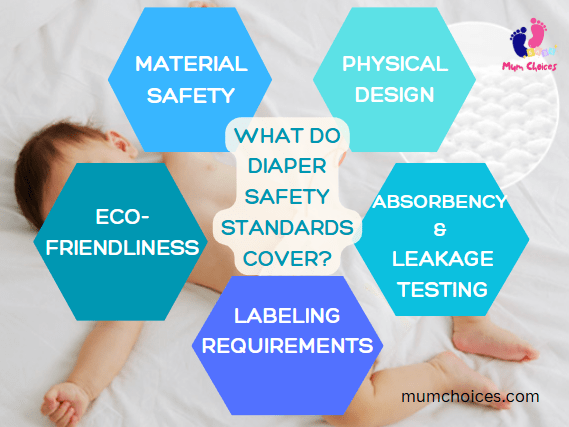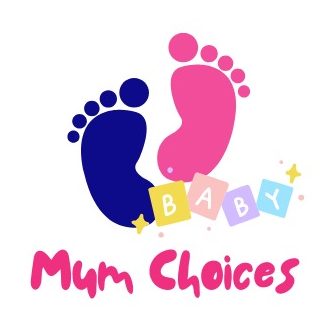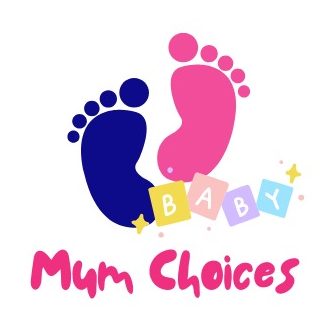When I first held a diaper for my baby, one thought filled my mind: ‘Is this safe?’ In 2025, that question matters even more. Every day, parents change about 350 million diapers worldwide. Behind each one is a system of safety checks and rules.
At first, I thought diaper safety was simple. If it absorbs well and feels soft, it must be fine, right? But there’s more to it. The materials touch my baby’s skin. Chemicals are used in the process. Each part must go through tests to prove it’s safe.
Every year, thousands of babies have diaper-related issues. Some get mild rashes. Others face serious allergic reactions. The U.S. Consumer Product Safety Commission tracks these cases. That’s why strict safety rules exist. But who decides the safety standards for baby diapers?
The answer isn’t simple. Many groups worldwide work together to decide. Governments, scientists, and industry experts each play a part.
In this article, I’ll explain who sets the rules, how they test them, and why it all matters. This isn’t just about rules. It’s about real knowledge that helps us, as parents, choose better. After all, our babies’ health depends on it.
What is Diaper Safety?
Diaper safety refers to the standards, regulations, and best practices for baby diapers. It ensures that diapers are safe for babies. It ensures diapers don’t have harmful chemicals. They need to absorb well and allow air to flow. Diapers should also be soft and gentle on a baby’s skin.
Who Sets the Safety Standards for Baby Diapers?

Different organizations worldwide regulate the safety of baby diapers.
Globally recognized organizations
ASTM International: It focuses on standards. These standards cover many industries, including baby products. One of their standards is ASTM F2285-22. It addresses durability. It also looks at absorption levels.
ISO: It sets rules to make sure products are reliable worldwide. These rules help keep products consistent. Following these standards isn’t just about checking off a list. It’s about keeping a balance between safety and profit.
ISO 8124 (toy safety) affects standards for diaper adhesives. The goal is to prevent choking hazards.
Government Regulatory Agencies
United States
- Consumer Product Safety Commission (CPSC) – It oversees the safety of baby products. This ensures they are free from harmful substances. It also makes sure products meet performance standards.
- Food and Drug Administration (FDA) –It regulates diaper materials to make sure they are non-toxic. This ensures they are safe for long-term skin contact.
- Environmental Protection Agency (EPA) –It monitors the environmental impact of diaper production. This includes checking chemical content and disposal guidelines.
Europe
- European Chemicals Agency (ECHA) –It enforces the REACH rule. This makes sure diapers are free from harmful chemicals. REACH means Registration, Evaluation, Authorisation, and Restriction of Chemicals.
- European Commission (CE Marking) –It certifies that diapers follow EU safety rules.
- OEKO-TEX® Standard 100 Certification – Many European brands follow this certification. It ensures diaper fabrics are free from harmful substances.
Other Global Diaper Regulations
- Japan: Japan Hygiene Products Industry Association (JHPIA) – It controls diaper safety. It also sets labeling rules.
- China: National Medical Products Administration (NMPA) –It controls diaper safety. It also sets labeling requirements.
- India: Bureau of Indian Standards (BIS) – It sets hygiene and quality standards for diaper makers.
What Do Diaper Safety Standards Cover?

Diaper safety standards vary by region. Still, they all focus on protection and quality. No matter the country, diaper manufacturers must meet specific safety criteria. These include:
- Material Safety
- Banned Substances: Diapers must be free from harmful chemicals,heavy metal and dyes.
- Hypoallergenic Design: Diapers should be fragrance-free and latex-free to prevent rashes.
- Physical Design
- Choking Hazards: Fasteners must be secure. Snaps are better than loose tabs.
- Breathability: Diapers should have microporous layers. These help reduce heat and moisture.
- Absorbency & Leakage Testing
- Diapers must hold 30 times their weight in liquid (ISO 11948-1). They must also prevent leaks when the baby moves.
- Labeling Requirements
- Diapers must have full ingredient lists. They should also include age and weight guidelines. Certification logos, like OEKO-TEX, must be visible.
- Eco-Friendliness: Some regulations focus on biodegradable and sustainable materials to reduce environmental impact.
How are the diaper safety standards enforced?
Mandatory Compliance:
Governments inspect products randomly. They recall products if there are problems. The EU’s Safety Gate tells parents about unsafe products.
Voluntary Certifications:
Brands like Pampers and Hello Bello get certifications like JPMA or OEKO-TEX. These help build trust with parents.
Third-Party Testing:
Labs like Intertek and SGS test diapers. They make sure the diapers follow local laws.
How is diaper safety ensured?
- Testing confirms diapers are safe and free from harmful chemicals.
- Certification verifies compliance with safety standards.
- Assessment is continuous throughout the product’s lifecycle.
Diaper testing and certification processes
Testing diaper safety invloves many steps. Diapers must pass tests for harmful chemicals. If they pass, they get certified. This means they are safe for babies. In India, diapers need BIS certification. This checks absorbency and softness. It also checks breathability and chemical safety. In the United States, diapers need CPC certification. Third-party labs test them. Rules are updated often to keep diapers safe.
Comprehensive tests for skin irritation and toxicity
Testing starts with small trials. Manufacturers put diaper materials on skin patches. This checks for irritation. Next, they test for harmful chemicals. Labs check the materials for safety. If the diaper passes, it gets certified. This ensures it is safe before selling.
Conduct material analysis
- Identify potentially harmful substances: Manufacturers check materials. They look for harmful substances and allergens. They use methods like chromatography to check closely. If they find anything bad, they remove or replace it. Safety teams make sure the removal works.
- Ensure no skin irritants: Once harmful substances are found, they do more tests. They check for skin irritants. This includes dermatological tests to make sure it’s safe.
Perform usability testing
- Test for fit and comfort: Fit tests check how babies move and how the diaper fits. Technicians watch and make changes if needed. Comfort tests use feedback from parents and doctors. Absorbency tests use saline to see how the diaper holds up under pressure. Leakage checks happen often to keep quality high.
- Monitor for leakage and absorbency: Tests check how well the diaper holds liquid. Machines simulate real conditions to test for leaks.
Strict tests and certifications keep the diaper safe. Regular reviews ensure it meets safety rules. Quality checks make sure the diaper stays safe and works well over time.
Why Safety Standards for Baby Diapers Are Important
Not all diapers are the same. Some contain harsh chemicals, synthetic fragrances, or rough materials. As a mom, I know how soft a baby’s skin is—but also how easily it gets irritated. Since it’s thinner and more sensitive than adult skin, it absorbs things faster.
- Safer products reduce risk.
- Fewer recalls save money.
- Builds customer trust with clear compliance
Benefit 1: Enhanced Safety
Safety standards help keep diapers safe for babies. They lower risks like rashes and skin irritation. Tests check for harmful chemicals to protect infants. Since diapers touch a baby’s skin all day, they must be free from unsafe materials.
Many parents trust brands that follow strict rules. These brands use safe materials that do not cause skin problems or health risks.
Diapers must pass safety tests for chemicals like dioxins and phthalates. These chemicals get a lot of attention because they may be harmful. Experts say, “Babies are more at risk from chemicals than adults.” Their skin absorbs more, making safety even more important.
Strong safety rules help protect infants. They make sure diapers do not have harmful ingredients. This keeps babies safe, happy, and rash-free.
Benefit 2: Improved Brand Reputation
Meeting safety standards builds a brand’s reputation. Parents trust certified products. This makes them more likely to stay loyal.
Brands that focus on safety can use their certifications in marketing. This shows their commitment to baby health. It also builds trust. Trust leads to a strong customer base and a competitive edge.
Transparency matters too. Certifications like EWG VERIFIED prove a diaper is free from harmful chemicals. Parents want to know what materials are in baby diapers. Most expect full disclosure.
Benefit 3: Legal Protection
Following safety rules helps companies avoid legal trouble. Diaper recalls cost a lot. They lead to lawsuits and lost trust. This can be more expensive than following safety rules from the start.
Sticking to standards prevents these problems. Lawsuits hurt both money and reputation. Since safety rules are common now, companies must stay careful.
Regulatory bodies like CPSC check diaper safety. Breaking the rules is risky. Most companies can’t afford it. Meeting safety rules keeps them out of trouble. It also helps prevent future problems.
Benefit 4: Quality Assurance and Performance
Safety standards ensure quality. Diapers must soak up moisture well. Leak protection keeps babies dry. This makes the product reliable and builds trust.
Safety and quality work together. Following rules makes diapers better. High standards make them more comfortable.
Sticking to safety rules helps diapers improve. Companies can track how well they follow rules. This helps them stay safe and make better diapers.
Benefit 5: Competitive Edge Through Innovation
Companies that follow safety rules can lead in innovation. They add safety tests early in design. This helps them make solutions that meet or beat the rules. Tougher safety standards spark new ideas. As rules get stricter, there is more room to improve materials and production.
How Can Parents Ensure the Diapers They Use Are Safe?
When I first became a mom, choosing the right diaper felt hard. There were so many options, and I wanted to make sure I picked one that was both safe and comfy for my baby. I quickly learned that not all diapers are the same. I had to think about a few key things to make sure I was making the best choice.
Here are some tips:
Check Labels for Certifications
- OEKO-TEX: Guarantees no harmful chemicals.
- EU Ecolabel: Ensures eco-friendly materials.
- FSC Certified: Confirms sustainable wood pulp sourcing.
Avoid Red Flags
- Terms like “natural” without certification.
- Missing ingredient lists or safety disclaimers.
Stay Informed about diaper safety guidelines:
- Subscribe to recall alerts from CPSC (U.S.) or EU Safety Gate.
- Use EWG’s Diaper Guide to compare brands.
Final Thoughts: Who sets the regulations for safe baby diapers?
To sum it up: safety standards for baby diapers are set by a mix of experts. Government agencies, industry groups, and diaper makers all work together. They want to make sure diapers are safe and free from harmful chemicals.
Regulatory groups, like the Consumer Product Safety Commission (CPSC), help set these rules. International groups, like ISO, also help with the process. Diaper makers must follow these rules. They test their products to make sure they are safe.
Parents should stay informed about diaper safety. Look for safety labels on diapers. It’s also important to research diaper brands. Understanding how diapers are tested can help parents feel confident in their choice. When parents stay aware, they can make the best choice for their babies. This will keep their little ones safe and comfortable.
Stay informed and choose wisely—your baby’s health depends on it!

